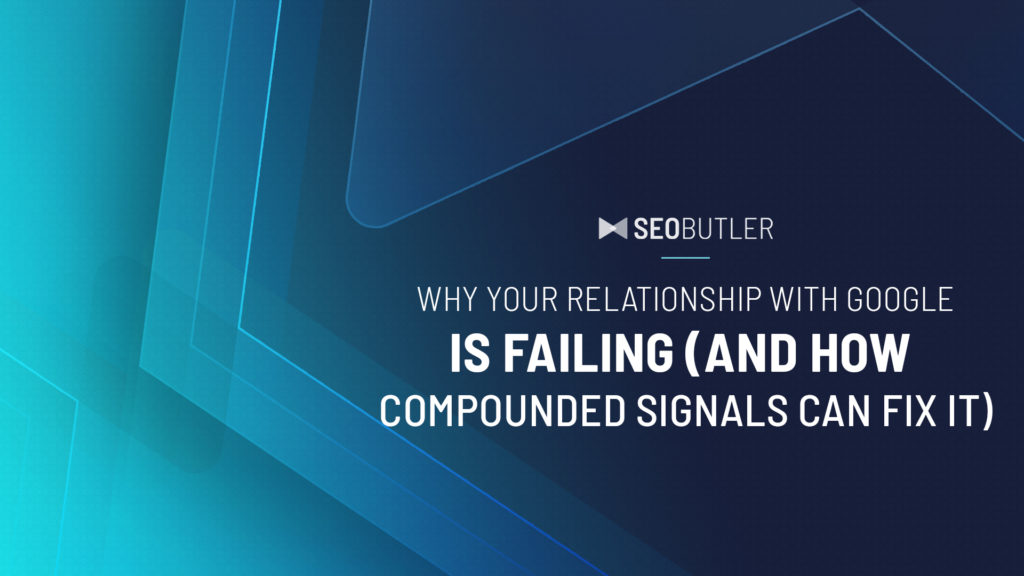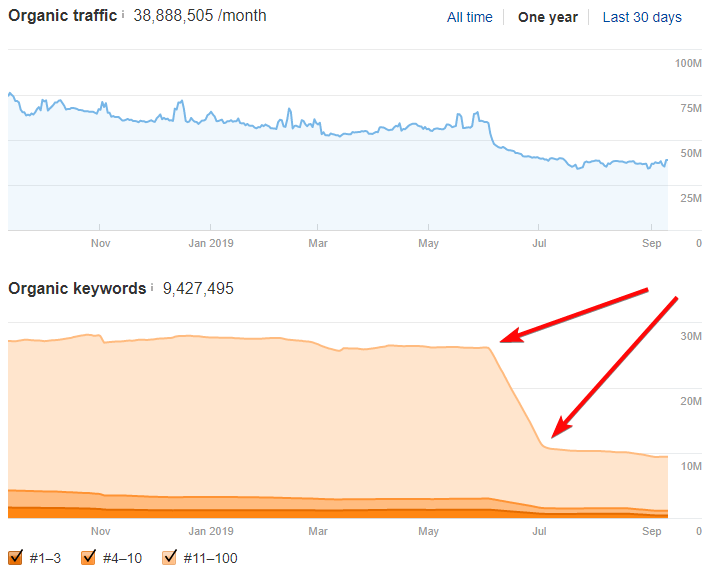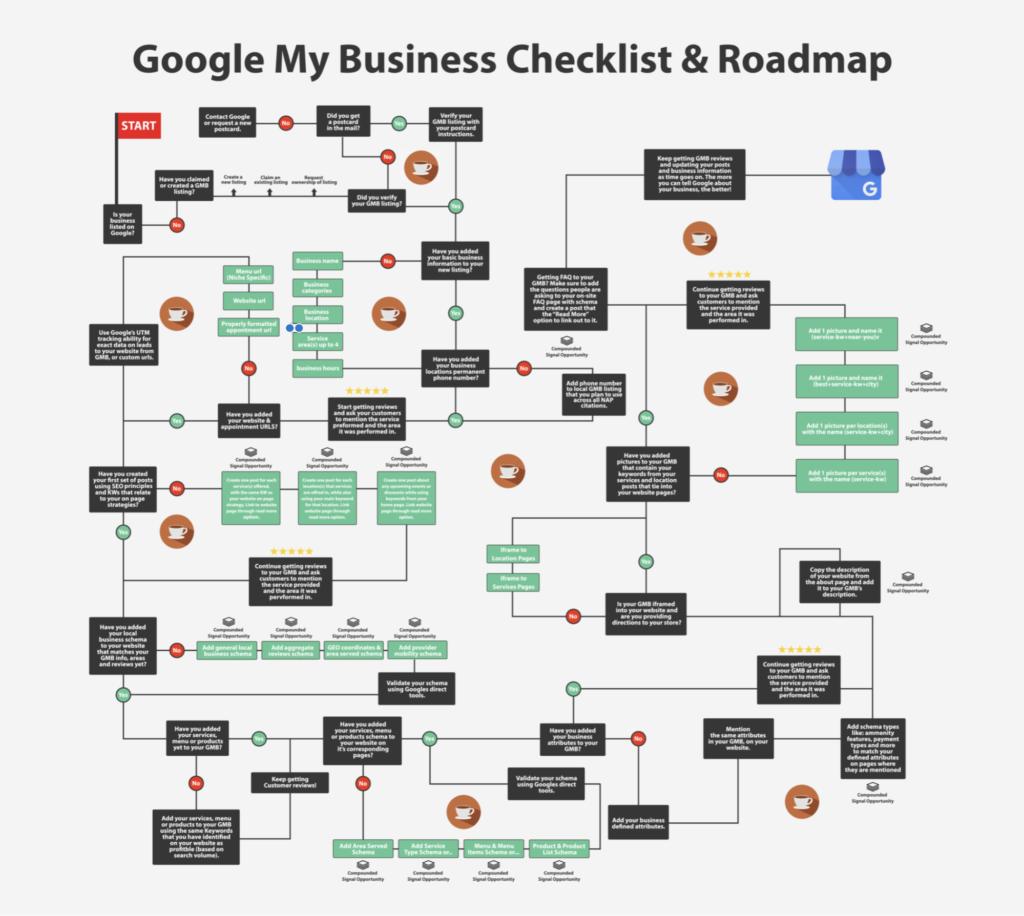Why Your Relationship With Google Is Failing (And How Compounded Signals Can Fix It)

This article is a guest contribution – read more about the author at the bottom of the post.
Human beings tend to confuse each other.
Especially when it comes to communication.
Despite our noblest attempts at clarity, we misuse words.
We exhibit unintended body language.
We assume the worst when something is unclear.
People send each other mixed signals in numerous ways.
Luckily, most people can read contextual cues and use them to better understand what others are trying to say.
Search engine algorithms can’t do this (yet).
Google constantly receives mixed signals from digital properties, putting their relationship at risk.
As a result, it’s not uncommon for Google to seek better relationships elsewhere.
In order to solidify your site’s relationship with Google, you—as an active digital entity—must signal that you seek a high-quality, long-term mutual exchange.
Let’s delve into how you can do this by sending compounded signals to Google from all your properties.
Let’s show Google you’re looking for a long-term relationship.
What are Compounded Signals?
Compounded Signals (in SEO) are the exponential enhancement of a major signal, resulting from the alignment of various other supporting signals.
Compounded signals are not new in principle or theory.
In fact, major SEO outlets frequently describe compounded signals on a granular level.
But too often, they pay scant attention to the role compounded signals can play in the macro development of digital assets.
If you’re familiar with SEO, cast your mind back to a time when you learned the explicit process of using your website’s main keyword:
- In the home page title
- In its description
- In heading tags
- In contextual references on the page
Utilizing a keyword in this way provides an example of on-page signal compounding.
You reference a single signal that search engines use, then reinforce it through multiple instances.
Other examples of signals that can compound to improve your SEO include:
- Positive reviews on third-party sites (such as TrustPilot or Capterra)
- Social media mentions
- Consistent NAP across all platforms
The opposite of compounding signals would be, for example, referencing your Google My Business (GMB) property’s name with something other than what appears on your website or elsewhere online—such as NAPs for local citations.
Now that you have a basic understanding of what compounded signals are, you may ask yourself…
Why Should I Care About Compounded Signals?
Let’s take a trip back to June of 2019, when the SEO world was abuzz with questions and frustration—even outrage—related to Google’s Core Algorithm Update.
Large properties with enormous amounts of traffic took nosedives.
Smaller, unsuspecting websites found their way to the top of SERPs almost overnight.
This volatility caused widespread panic among SEOs.
Google remained largely silent about the update and its potential impact—aside from stating the new algorithm may reassess previously indexed content.
Additionally, we learned Google rolled out a diversification algorithm designed to inhibit multiple URLs with the same root domain from appearing in the SERPs.
Pretty ambiguous, right?
I thought so too, until I started digging deeper into the over 200 properties I have access to.
The correlations I found were rather conclusive.
After extrapolating data from these properties and comparing it to major outlets, what I determined was this:
Properties sending ambiguous signals to Google about their purpose, their content and their brand lost large amounts of traffic and visibility.
As referenced above, Google openly admits to re-assessing indexed content (both on and off-site).
My research shows that when high priority signals don’t align, a property may drop in the SERPs in favor of sites that don’t send mixed signals.
Here’s an example:
Two notable websites that took a hit during this last core algorithm update were dailymail.co.uk and CNN.com.
Major SEO outlets reported upwards of a 50% decrease in traffic and many pages lost visibility on Google for multiple topics.
Let’s take a closer look at why the below happened to dailymirror.co.uk:
Given the available data, the SEO world puzzled as to how such a steep decline was possible.
How could a website doing so well—and growing in organic traffic—lose such a large share of the pie in an instant?
So what happened to The Daily Mail, and how does it pertain to compounded signals?
After the Core Update happened, I took it upon myself to figure out what was going on with dailymail.co.uk.
I wanted to uncover substantial correlations to form a theory of why Google’s new algorithm impacted the website so negatively.
Most importantly, how could other SEOs avoid the same outcome?
I began by going through the audits and running the reports that most technical SEOs would, including:
- Competitor Analysis
- Traffic Analysis
- Backlink Profile Analysis
- On-Page SEO Analysis
- Technology Profile Analysis
The reports revealed little beyond the anomalies that occur for most web properties now and again.
I began looking around forums and SEO blogs to see if they had any revealing information regarding how or why this had happened.
Most assertions revolved around the Expertise, Authority, and Trustworthiness (E-A-T) algorithms.
I spent a few days running multiple reports.
It dawned on me while I was looking into large clients—whose rankings had been adversely affected by the Core Update— that their negative reviews had been increasing over time.
I then asked myself one simple question:
What compounded signals are sent to Google about this property external to its own assets?
The results were just what I had been looking for!
Let’s take the first screenshot below from TrustPilot—a popular consumer review platform founded in Denmark.

When we examine the negative reviews consumers have posted, there are easily identifiable common threads.
Here are some examples below:
Aside from the negative reviews, it’s crucial to note many users complained about site speed and an inability to load the website.
I generated a report for dailymail.co.uk on GTmetrix and correlated the reviewer complaints with the website’s actual metrics.
Take a look:
GTmetrix report as of 08/23/2019
The TrustPilot reviews were just the tip of the iceberg.
If you head over to Google and type in the search parameters of “dailymail.co.uk + reviews” you’ll find a wide array of websites, reviews, and individuals saying that the website is:
- Slow
- Unusable
- Full of bloatware
- A platform for click-bait and biased reporting
I extrapolated that dailymail.co.uk’s drop in ranking was caused by its authority being diminished by offsite signals compounding for thousands of bad reviews—leading Google to take action.
Despite an excellent backlink profile from a purely metric-based standpoint, the context of dailymail.co.uk’s backlinks was unfavorable.
Google’s Core Algorithm update for 2019 clearly responded to this signal.
Important note: This correlative evidence is based on hours of research.
The main takeaway is not that negative reviews or site speed specifically caused the loss of traffic for dailymail.co.uk.
Rather, the ongoing compounding of negative authority and site speed signaling was to blame.
How This Data Correlation Impacts Your Properties—From Local to National
Now that we have an understanding of what compounded signals are and why we should care about them, let’s discuss how they can affect any website from local to national.
Think about the first website that comes to mind right now—maybe one you have been working on for a while.
It could be a local painter or it could be a national medical property—the vertical doesn’t matter much.
With this in mind, I want you to consider the macro of the website…
How might search engines “feel” about it based on contextual and technical signals?
Ask yourself the following:
- Is my GMB aligned with my on-site information (Description, Number, Address, Company Name)?
- Can I compound signals in schema that reference my site’s information and also reflects my GMB?
- Is my on-page SEO compounding signals for topical relevance?
- I say that I am the “#1 Painter in Town.” Do my reviews and authority actually support this claim?
- Do my backlinks signal source reliability to search engines?
- Does my “About” page signal contextual relevance to my site’s purpose?
- Do my author’s profiles signal expertise in their fields?
Take this local GMB below as an example.

What search engines see is a misaligned signal that doesn’t compound.
If the name of the company was “Gamers Warehouse iPhone Screen Repair – Samsung Phone Repair- iPad Screen repair LLC,” there would be no contextual differences between this signal and other signals for this entity.
However, that’s not the case.
If you visit the website, their brand signal is “Gamers Warehouse,” not the longer name above.
Going back to dailymail.co.uk, if we take a look at the signals related to the authority of contributors, we see a misalignment almost immediately.
Authors for the site have no contextual references in their on-site biographies to communicate that they’ve been vetted and are noteworthy journalists.
Upon inspection of one such author’s background as a journalist, we found no context for his accolades or applicable journalism experience on any professional platform.
His Twitter had only 120 followers and we couldn’t find a Linkedin profile.
The two examples above quickly show how mixed or negative signals can become an issue for search engines seeking to establish relevant returns for queries.
How to Fix Your Relationship With Google Through Signal Alignment
By now, hopefully, I’ve clearly expressed how crucial signals are from a technical and contextual standpoint.
As online businesses grow over time—and new ones come into existence—major search engines like Google feel a responsibility to curate verifiable, legitimate, and trusted content for their users.
So, how do we ensure that our web properties align with Google’s vision of what constitutes high-quality content?
We adapt our mindset as SEOs.
We align our signals across the board and reinforce them over time through all available platforms.
These include:
- On-Page SEO Signals
- Off-Page SEO Signals
- Technical SEO Signals
- Contextual SEO Signals (Positive Mentions not Negative)
- GMB Signals
- Social Media Signals
- Paid Advertisement Signals
To give a real-world example, if you wanted to compound a signal for “iPhone Repair” across all of these properties, you would:
- Create a page or post around “iPhone Repair” with a hierarchical structure (website.com/repairs/iphone)
- Follow all on-page semantic rules of SEO and place your KW for “iPhone Repair” in:
- The Title (iPhone Repair Service in Atlanta | Website.com)
- In the H1 (iPhone Repairs For all Models in Atlanta)
- In the H2 as a synonym (Apple Repairs & Services We Offer On Phones)
- In the body of your content
- A picture (iPhone Repair & Services in Atlanta), with an alt tag that has your KW.
- Place schema on your page with company, service, geo, and breadcrumb schema to compound your signal up through your keywords and into the structure of the site itself.
- Create backlinks on social media that contextually define what your service is, inside of groups local to your geography. Backlinks from other sites can be used in the same way as long as they are positive mentions and not people discussing your property or its brand name in negative ways (see dailymail.co.uk above).
- Compound the signal further in your GMB by adding iPhone Repair as a service. Then create a GMB post about the service. The post can use the “Read More” link to refer back to your website page for “iPhone Repair.” After this is complete, ask a customer to leave you a review about repairing their iPhone. Request that they mention the service your business performed for them and in what location. This further compounds its relevance.
- Create ad copy with the phrase and send even more traffic signals back to your website and Google. Give contextual reference to the paid keywords on your site or page’s topic. If you are running a Google ad (which is near impossible for the example niche at this point), you might capitalize on the KW, iPhone Repair.
Once these steps aggregate, a compounded signal is created and sent to the search engine—leaving no doubt that the page is for iPhone Repair.
Any misalignment of these signals may diminish a search engine’s understanding of the property’s purpose.
There are many more signals which can be sent to Google—or any other search engine.
These signals help define your business as an online entity.
Following the above steps should help ensure Google doesn’t get your site’s signals crossed.
Bonus Download! The SEO Roadmap to Compound GMB Signals (Local Only)
I often get questions asking how to compound signals from GMB to a website.
After all, with Google as the authority, compounding signals from their own platforms makes sense, right?
As a bonus feature, SEOButler has included a roadmap for local SEO below to help your GMB skyrocket.
I listed each step with a compounded signal opportunity to give you an advantage over your competition.
Download High-Res Roadmap Here
Final Thoughts
As Google’s DeepMind architecture evolves, I predict that contextual signals—aligned with compounded technical signals—will become ever more crucial to SEO.
I urge all of you to execute your SEO strategies with compounded signals front-of-mind—even while the concept is still in its infancy.
Execute Your SEO Principles Today, With the Future in Mind
Have you had any experience with compounded signals impacting your web properties?
For better or for worse?
Let us know all about it in the comments!
[cta]
[author_bio image=”https://seobutler.com/wp-content/uploads/2019/07/Schieler-Mew-Headshot-Cropped-150×150.png” name=”SCHIELER MEW”]Schieler Mew is a Digital Marketing Strategist and Comprehensive SEO consultant that has worked with Fortune 500 companies all the way down to local SMB’s. He specializes in advanced SEO theory and technical concepts to help online businesses thrive in evolving and volatile markets. Schieler is the owner of <a href=”https://viictorymedia.com”>Viictory Media</a>[/author_bio]
8 thoughts on “Why Your Relationship With Google Is Failing (And How Compounded Signals Can Fix It)”
Leave a Reply
You must be logged in to post a comment.







Sooooo much information. Thanks for taking the time to write this, a lot of great information and that roadmap!!
Thanks so much for your kind words! Really appreciated 🙂 Schieler really outdid himself on this one!
This article has made me think about the way I approach SEO entirely. If Google is depending on us to “compound” our signals in order to make it clear to them what the intention is as a whole I would say most of us are failing. Incredible insight.
Very insightful. What about subdomain/subfolder renting for coupons related? Google started to penalizing commercial content who does this I think.
Interesting find here https://pip.net/searching-for-harm
Rai,
In short, coupon sites are getting penalized because they are compounded signals through inadequate backlink profiles that are clearly 70-90% sponsored links.
In addition, Coupon sites are not compounding trust and EAT factors. There’s usually no about or team page that accurately describes the intentions of the coupon site, who runs it, why and the motivational factors surrounding the creation of the website.
If the company is an actual company or corporation – one has to ask themselves why they are not.
These are my thoughts on the matter and I hope it sheds some light on your inquiry.
Schieler
Really valuable insights thanks for sharing & the GMB roadmap is excellent – plenty to work through!
Really good stuff here, Schieler. I hadn’t read this take on the algorithm consequences (and they why behind it) anywhere else.
Thanks. 🙂
Nice article, detailed insights on how compounded signals work and the keyword is a proven factor to optimize the website. Thanks for sharing.